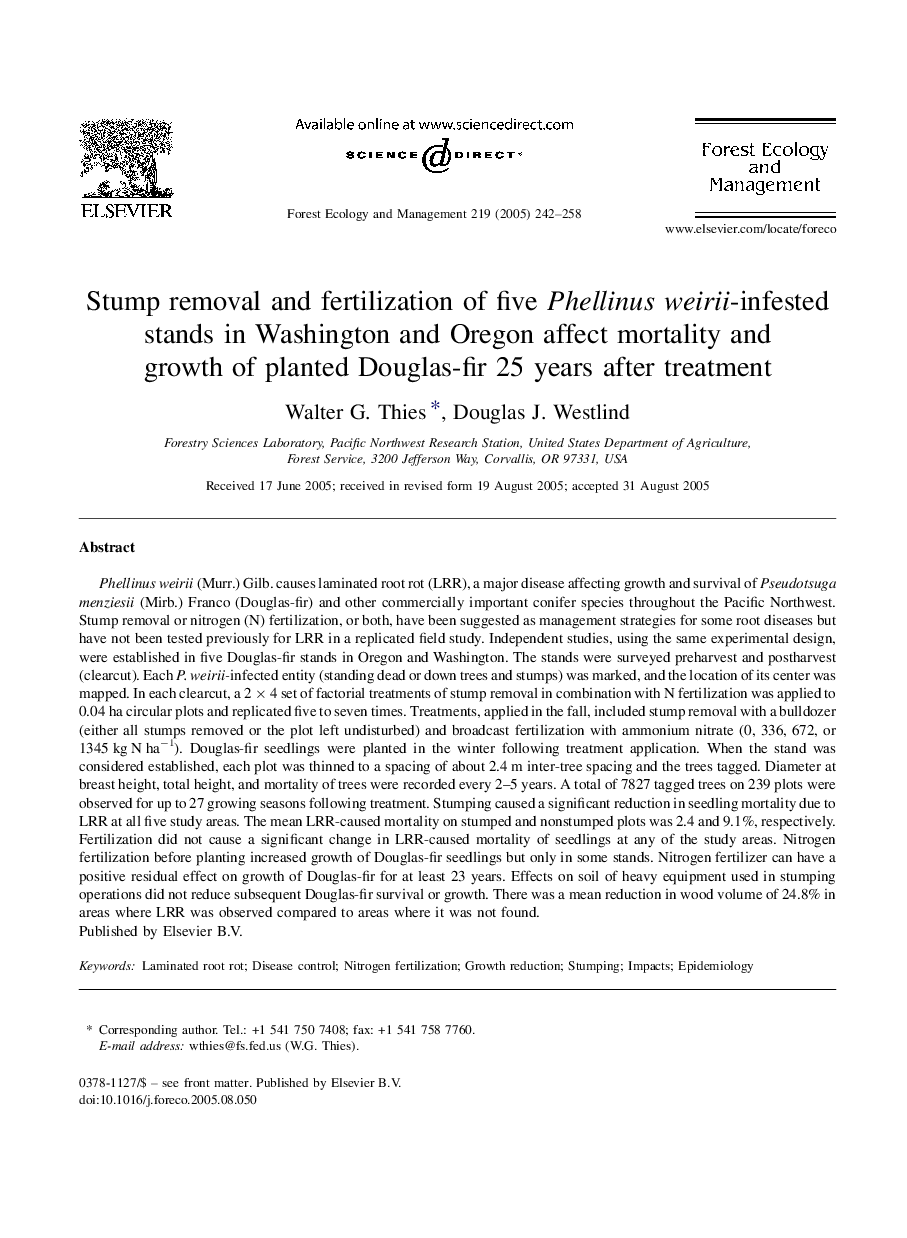| کد مقاله | کد نشریه | سال انتشار | مقاله انگلیسی | نسخه تمام متن |
|---|---|---|---|---|
| 9620109 | 159439 | 2005 | 17 صفحه PDF | دانلود رایگان |
عنوان انگلیسی مقاله ISI
Stump removal and fertilization of five Phellinus weirii-infested stands in Washington and Oregon affect mortality and growth of planted Douglas-fir 25 years after treatment
دانلود مقاله + سفارش ترجمه
دانلود مقاله ISI انگلیسی
رایگان برای ایرانیان
کلمات کلیدی
موضوعات مرتبط
علوم زیستی و بیوفناوری
علوم کشاورزی و بیولوژیک
بوم شناسی، تکامل، رفتار و سامانه شناسی
پیش نمایش صفحه اول مقاله

چکیده انگلیسی
Phellinus weirii (Murr.) Gilb. causes laminated root rot (LRR), a major disease affecting growth and survival of Pseudotsuga menziesii (Mirb.) Franco (Douglas-fir) and other commercially important conifer species throughout the Pacific Northwest. Stump removal or nitrogen (N) fertilization, or both, have been suggested as management strategies for some root diseases but have not been tested previously for LRR in a replicated field study. Independent studies, using the same experimental design, were established in five Douglas-fir stands in Oregon and Washington. The stands were surveyed preharvest and postharvest (clearcut). Each P. weirii-infected entity (standing dead or down trees and stumps) was marked, and the location of its center was mapped. In each clearcut, a 2 Ã 4 set of factorial treatments of stump removal in combination with N fertilization was applied to 0.04 ha circular plots and replicated five to seven times. Treatments, applied in the fall, included stump removal with a bulldozer (either all stumps removed or the plot left undisturbed) and broadcast fertilization with ammonium nitrate (0, 336, 672, or 1345 kg N haâ1). Douglas-fir seedlings were planted in the winter following treatment application. When the stand was considered established, each plot was thinned to a spacing of about 2.4 m inter-tree spacing and the trees tagged. Diameter at breast height, total height, and mortality of trees were recorded every 2-5 years. A total of 7827 tagged trees on 239 plots were observed for up to 27 growing seasons following treatment. Stumping caused a significant reduction in seedling mortality due to LRR at all five study areas. The mean LRR-caused mortality on stumped and nonstumped plots was 2.4 and 9.1%, respectively. Fertilization did not cause a significant change in LRR-caused mortality of seedlings at any of the study areas. Nitrogen fertilization before planting increased growth of Douglas-fir seedlings but only in some stands. Nitrogen fertilizer can have a positive residual effect on growth of Douglas-fir for at least 23 years. Effects on soil of heavy equipment used in stumping operations did not reduce subsequent Douglas-fir survival or growth. There was a mean reduction in wood volume of 24.8% in areas where LRR was observed compared to areas where it was not found.
ناشر
Database: Elsevier - ScienceDirect (ساینس دایرکت)
Journal: Forest Ecology and Management - Volume 219, Issues 2â3, 25 November 2005, Pages 242-258
Journal: Forest Ecology and Management - Volume 219, Issues 2â3, 25 November 2005, Pages 242-258
نویسندگان
Walter G. Thies, Douglas J. Westlind,